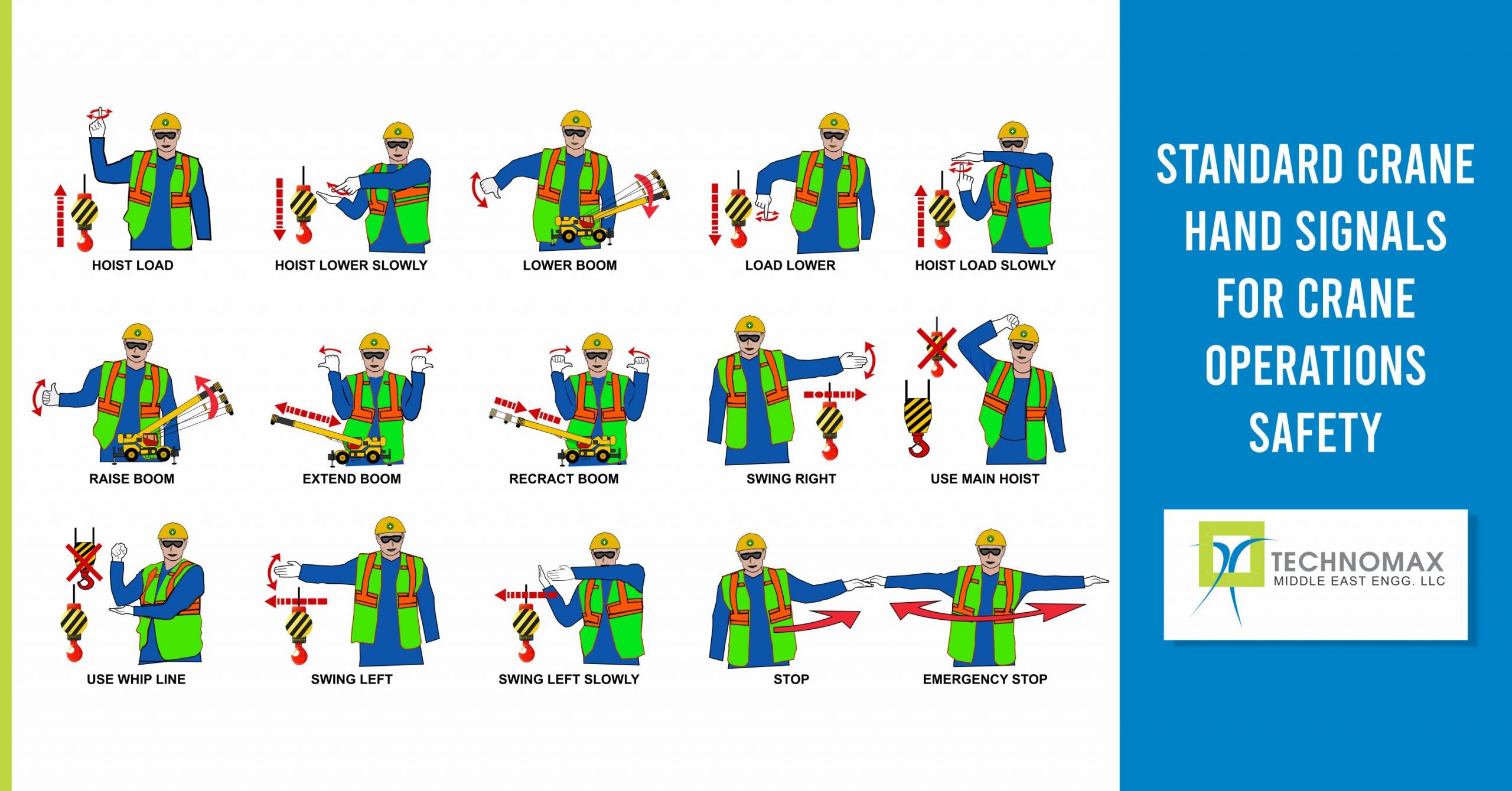
Standard Crane Hand Signals for Crane Operations Safety
Introduction
Hand signals for crane operations are utilized to direct crane operators in crane operation, such that the crane can operate safely. They are applicable to bridge crane, gantry crane, rail-mounted crane, tower crane, crawler crane, shipbuilding crane, Tyre crane, etc. for ensuring the safety of crane operations, meet the requirements of scientific management, prevent accidents, the crane operators should comply with the requirements of crane hand signals.
Also Read:
- Crane Load Testing – An Overview
- Crane Maintenance Services In UAE
- Top 5 Crane Operation Safety Tips
Standard hand signals for Crane Operations
Here are the standard hand signals for crane operations safety in detail-
Use the main hoist: Do a fist taps on top of the head, using other conventional signs.
Use whip line or auxiliary hoist: One hand holding the other hand's elbow and then use other conventional signals for crane operations safety.
Retract boom or one hand: One hang pinch, thumb outward, and the tail of fist points to the chest.
Extend boom or one hand: One hand; one hand pinch, one hand put in the chest's front, thumb points to the chest.
Hoist: With forearm vertical, forefinger pointing up and moving hand in a small circle vertically.
Swing: Extend arms horizontally with finger-pointing in a similar direction to the boom.
Lower: Do this with your arm extending downward, the forefinger pointing down, and moving the hand in a short circular way horizontally.
Raise boom: The arm is extended, the thumb pointed upward, and the fingers are kept closed.
Lower boom: The arm is extended horizontally, the thumb pointed in a downward position, and fingers are closed.
Extend boom: Keep both fists in the front of the body with thump pointing outward.
Retract boom: Both fists in front of the body with the thumb are pointing towards each other.
Move slowly: Place one of your hands in front of the body and use the other hand to give a moving signal and move it gently.
Raise the boom and decrease the load: Place one hand in front of your body with the thumb pointing upward, keep the other fingers closed, flex fingers in and out as long as the movement aspires.
Lower the boom and raise the load: You will need to place one of your hands in front of the body and keep the thumb pointing downward, and the other fingers opened and flexed. It will help if you keep your fingers in and out as long as the movement is desired.
Stop: Arm extended, palm down, move the arm back and forth horizontally.
Emergency stop: Arm extended, palm down, and move arms horizontally.
Requirements for signaling individuals and crane operators when using hand signals for crane operations
- Those who give signals should contact with crane operator according to the crane hand signals.
- The signs given by the signal person must be clear and accurate.
- Signal person should stand in a position where the crane operator can see the crane hand signals.
- Suppose the signal person is unable to see the crane operator and the load simultaneously. In that case, an intermediate signal person must be added to be transmitted step by step. The stop signal should be sent immediately when a wrong signal is found.
- Before using the load lower, the signal person must confirm the landing area security before the lower signal can be issued.
- When using two cranes for lifting a similar load, the signal person should direct each crane respectively to make sure synchronous lifting.
- The signal person must wear a distinctive sign like the armband marked 'command,' special color safety helmet, clothes, etc.
- The palm and back of the signal person’s gloves should be easily identified.
Responsibilities and requirements of crane operators when using crane hand signals
- The crane operator must follow the signal person only. If the signal is not clear, then the crane operator should issue a repeat signal to ask and then operate the crane continuously only when the indication is clear and correct.
- The crane operator must be accustomed to crane hand signals and co-operate with the signal person closely.
- When the signal person does a wrong crane hand signal, the crane operator has the right to refuse to perform the task.
- The crane operator must ring before operating the crane, and if needed, the ring is also required in the process of lifting.
- During lifting, the crane operator should always follow the ‘emergency stop’ signal made by a person.
Safety first
Safety is always the number one attention for crane operators. A person executing the hand signals withstand at a vantage point allows them to see the load area from a not noticeable viewpoint to the crane operator.
If operated incorrectly, Cranes can pose a significant danger to construction workers on the site and, in some cases, the public, but they do have incredible capabilities. Hand signals for crane operations are considered reliable, universal, and low-tech to improve safety during operation and avoid accidents.
Learn More About Our Services

Recent Blogs

Condition Monitoring: Enhancing Reliability and Efficiency in Industrial Operations
Condition Monitoring, as the name states, is a meticulous process involved in predictive maintenance schedules to evaluate the health, reliability,…

Get Started Now!
It takes less than a minute of your time. Or you may simply call +971 2 555 1 783





